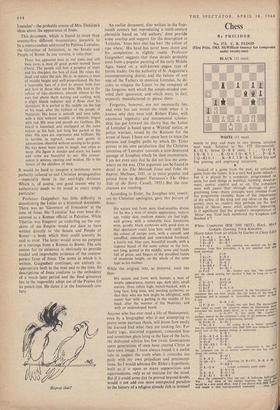Chess
By PHILIDOR
No. 173. C. R. FLOOD (First Prize, 1963, McWilliam tourney for composers under twenty-one) BLACK (II men)
WHITE (II men) WHITE to play and mate in two moves; solution next week. Solution to No. 172 (Groenveld): K—Q 8, threat Q—B 8 mate, I . . . Q—Q 4;
2 B—K 3. 1 B—Q 4; 2 Q—K 5. I .. P—K 4;
2 Q—Kt 6. I K—B 3: 2 B—K S. Good key and
fine pinning and unpinning variations.
Instead of a game from the past, an unfinished game from the future. It is a very bad game indeed— but it is played by a computer, programmed to score for such things as material, mobility, develop- ment, central control and so on. The compilers were well aware that—through shortage of pro- gramming time—many concepts Were omitted from the programme (notably those of the importance of the safety of the king and any ideas on the end game); even so, readers may perhaps see the first letters of 'Mene, mene, tekel, upharsin' appearing. Is it significant that the prophet's interpretation of 'Mane' was 'God hath numbered thy kingdom and finished it'?
White, COMPUTER IBM 7090 (MIT); Black, MILT GARnER. Opening, FOUR KNIGHTS. (Score taken from an article by Garber in Chess Life)
I P—K 4 P—K 4 2 Kt—QB 3 Kt—KB 3 3 Kt—B 3 Kt—B 3
4 P—Q 4 . . . this opening was worked out by fhe_, computer from first principles; it is not supplied with an, book openings.
5
4... PxP 11P x P
—B 4 4 .
6 KtxKt KtP x Kt P—K 5 Q—K 2
8 B—KB 4 P—Q 3
9 Q—K 2 Kt--Kt 5
10 PxP . . Mr. Garber says that 'the comPtlIef saw the check coming but decided it had to hang on to ils pawn.' 110 K—Q 2 QxQ ch
13 Bx P PxP B—K 6 ch 12 BXQ
14 K—Q 3 . . . see comment in the introduction: Ih.e computer has not been taught that the safety of the kingbe'' '', important and is engaged in 'controlling the centre' as it can.
14 B—R 3 ch . . .
IS P—B 4!! . illegal, but very fine! The instructions had failed to cover the situation where an intervening Pinc," Prevented the double pawn move. so it was allowed to soon... 15 . . 0-0-0?? At this point Mr. Garbcr"-i perhaps shaken by the computer's coup on the previous move'd could do with a little programming himself. 16 B x Kt ch K--Kt 2 pp 17 Kt—K 4 . . . Of course K x B is better: nevertbC!Q, less the elaborate manoeuvre that IBM 7090 now embarks on avoid loss of the pinned bishop is impressive.
17 . . . B-11 5 18 Kt—B 5 ch K—Kt 3 19 Kt—Q 7 ch R X Kt 20 B X R B X B 21 QR—KB I P—B 3 “Kg 22 R—B 5. . this curious manoeuvre is the 3
the computer can 'do at central control: no one has told 1 about the ending yet!
22 . . . R—Q 1 23 B—K 6 P—Kt 3 24 QR—B 1 . . . observing 24 R x PT?, B—K 4 eh 24 . . . P—KB 4
25 K—Q 4B. .—B . 4 ch former comments again apply.
25 . . .
26 K—B 3 B—Q 5 ch 27 K—Kt 3 K—B 4
Here the computer's time ran out. A• ludicrous half-1401' Yes . . . but think of the human beginner for whom would be a very good effort. And if one played with IBM 709Iri and taught it—and reprogrammed constantly . . . what the






































 Previous page
Previous page